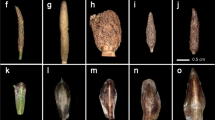Abstract
Hypotheses for the origins of tetraploids and hybrids ofSphenomeris chinensis sensu lato in Japan were tested using electrophoretic analysis of isozymes. Comparison of banding patterns supported the hypothesis that plants having abortive spores had resulted following hybridization between diploidS. chinensis var.chinensis andS. biflora and between diploid var.chinensis andS. gracilis. Results from isozymic analyses also revealed thatS. intermedia probably originated through allotetraploid speciation following hybridization between var.chinensis andS. biflora. There were two electrophoretic variants among tetraploids ofS. chinensis. One variant, restricted to the southern Ryukyu Islands, is probably an allotetraploid of hybrid origin between diploidS. chinensis andS. gracilis. It has been described as a new species,S. yaeyamensis Lin, Kato & K. Iwatsuki. The other variant, morphologically corresponding to var.chinensis, is distributed at least throughout southern Japan and also in northern Thailand. Its origin is uncertain, but one of the parents is probably diploidS. chinensis. Sphenomeris intermedia andS. yaeyamensis occur inland, whereas the parentalS. biflora andS. gracilis are halophilous and rheophllous, respectively.
Similar content being viewed by others
References
Austin, R.B. 1989. Prospects for improving crop production in stressful environments.In H.G. Jones, T.J. Flowers and M.B. Jones, eds., Plants under Stress, Cambridge Univ. Press, Cambridge, pp. 235–248.
Bir, S.S. 1965. Chromosome numbers in some ferns from Kodaikanal, South India. Caryologia18: 107–115.
Cardy, B.J., Stuber, C.W., Wendel, J.F. andGoodman, M.M. 1983. Techniques of starch gel electrophoresis of enzymes from maize (Zea mays L.) Inst. Statist. Mimeogr. Ser. No. 1317R, North Carolina State Univ., Raleigh.
Fahn, A. 1990. Plant Anatomy. 4th ed. Pergamon Press, Oxford.
Flowers, T.J., Hajibagheri, M.A. andClipson, N.J.W. 1986. Halophytes. Quat. Rev. Biol.61: 313–337.
Gastony, G.J. andWindham, M.D. 1989. Species concepts in pteridophytes: The treatment and definition of agamosporous species. Amer. Fern. J.79: 65–77.
Iwatsuki, K. (ed.) 1992. Ferns and Fern Allies of Japan. Heibonsha, Tokyo.
Kato, M. andImaichi, R. 1992. Leaf anatomy of tropical fern rheophytes, with its evolutionary and ecological implications. Can. J. Bot.70: 165–174.
Kato, M., Nakato, N., Cheng, X. andIwatsuki, K. 1992. Cytotaxonomic study of ferns of Yunnan, southwestern China. Bot. Mag. Tokyo105: 105–124.
Kramer, K.U. 1968. The lindsaeoid ferns of the Old World. III. Notes onLindsaea andSphenomeris in the Flora Malesiana area. Blumea15: 557–574.
Kramer, K.U. 1971.Lindsaea-group.In R.E. Holttum, ed., Flora Malesiana, Ser. 2 (Pteridophyta), Vol. 1, Martinus Nijhoff, The Hague, pp. 177–254.
Kramer, K.U. 1972. The lindsaeoid ferns of the Old World. VI. Continental Asia, Japan and Taiwan. Gard. Bull. Singapore26: 1–49.
Kurita, S. andNishida, M. 1963. Cytotaxonomy of JapaneseSphenomeris. J. Jap. Bot.38: 4–7.
Lin, S.-J., Kato, M. andIwatsuki, K. 1990. Sporogenesis, reproductive mode, and cytotaxonomy of some species ofSphenomeris, Lindsaea, andTapeinidium (Lindsaeaceae). Amer. Fern J.80: 97–109.
Lin, S.-J., Kato, M. andIwatsuki, K. 1994. A taxonomic study of the fern genusSphenomeris (Lindsaeaceae) in Japan. J. Jap. Bot.69: 127–141.
Manton, I. andSledge, W.I. 1954. Observations on the cytology and taxonomy of the pteridophyte flora of Ceylon. Phil. Trans. Royal Soc. London, B.238: 127–185.
Mehra, P.N. andKhama, K.R. 1959. Cytology of some Himalayan ferns. J. Genet.56: 1–14.
Mitui, K. 1975. Chromosome numbers of Japanese pteridophytes. Bull. Nippon Dental College, Gen. Educ.4: 221–271.
Nakaike, T. 1982. New Flora of Japan: Pteridophyta. Shibundo, Tokyo.
Roy, R.P. andPandey, S.N. 1962. Cytotaxonomical studies of the fern flora of Parasnath Hills. Proc. Ind. Sci. Congr.49: 333–334.
Roy, S.K. andRao, A.N. 1985. A brief cytotaxonomic survey of Singapore ferns. J. Singapore Natl. Acad. Sci.14: 53–64.
Soltis, D.E., Haufler, C.H., Darrow, D.C. andGastony, G.J. 1983. Starch gel electrophoresis of ferns: A compilation of grinding buffers, gel and electrode buffers, and staining schedules. Amer. Fern J.73: 9–27.
Ungar, I.A. 1991. Ecophysiology of Vascular Halophytes. CRS Press, Boca Raton, Florida.
van Steenis, C.G.G.J. 1981. Rheophytes of the World. Sijthoff & Noordhoff, Alphen aan den Rijn, the Netherlands.
Weeden, N.F. andWendel, J.F. 1989. Genetics of plant isozymes.In D.E. Soltis and P.S. Soltis, eds., Isozymes in Plant Biology, Dioscorides Press, Portland, Oregon, pp. 46–72.
Werth, C.R., Guttman, S.I. andEshbaush, W.H. 1985. Electrophoretic evidence for reticulate evolution in the AppalachianAsplenium complex. Syst. Bot.10: 184–192.
Author information
Authors and Affiliations
Rights and permissions
About this article
Cite this article
Lin, SJ., Kato, M. & Iwatsuki, K. Electrophoretic evidence for the origins of tetraploids and hybrids ofSphenomeris chinensis sensu lato (Lindsaeaceae) in Japan. J. Plant Res. 109, 201–209 (1996). https://doi.org/10.1007/BF02344546
Received:
Accepted:
Issue Date:
DOI: https://doi.org/10.1007/BF02344546




